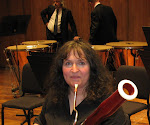My vibrato history is odd, to say the least. During high school, my teacher didn’t believe in allowing kids to either use vibrato or play the Mozart Bassoon Concerto. (He was old school, for sure.) As a result of the vibrato ban, I developed a hangup about it. At the Eastman School of Music, I stood out as the freshman bassoonist with no vibrato. I can only imagine what Mr. Van Hoesen was thinking regarding his decision to accept me as a student! He begged for vibrato, but it just wouldn’t happen.
Then one day, Mr. Van Hoesen decided to try something unorthodox. He brought in a machine which measured air pressure. When its tube was inserted into a bassoonist’s mouth, the meter displayed any change in air pressure while the bassoonist played.
That machine changed my life. Instantly, I had vibrato, and it was pretty decent from the very start. I don’t know if that machine has worked miracles on any other students since then, but I do know that Mr. Van Hoesen asked me to help a couple of other students with their vibrato! His idea to use that machine on me was a stroke of genius.
Mr. Van Hoesen always encouraged his students to listen to recordings and live performances of the great singers, string players and pianists. That’s how we learned musicianship, including rubato and vibrato. He insisted that we take note of the way the vibrato changed according to the phrase.
One thing that I’ve noticed about vibrato from a bassoonist’s standpoint is that not only does each note on the bassoon vibrate differently, but some bassoons are more vibrato-friendly than others. In fact, I use vibrato as an important factor when evaluating an intrument. One bassoon which I liked in every other way ended up not being right for me because it was vibrato-resistant!
My new Heckel allows me to match the vibrato from note to note, without any notes sounding either too wild or too inflexible. It reminds me of the French basson in that regard. I have always thought that the French basson lent itself to a very easy, natural vibrato. Just listen to any recording of the great Maurice Allard!
I practice vibrato by turning on the metronome to 60 and vibrating on long tones at either 4 or 5 pulsations per beat throughout the range. (I read an article recently which stated that vibrato sounds best at 4-6 pulsations per minute- any slower sounds wobbly. There was also speculation that pop singers' vibrato varies more in amplitude, whereas classical singers' vibrato varies more in pitch, and that the ideal classical pitch component varies by no more than a semitone around the main note.)
Inevitably, even when playing on the most agreeable of bassoons, some notes are going to be a bit tougher to control than others. Following the exercise described above, I play long tones with vibrato changing gradually from none to excessive and vise versa, with and without crescendos and decrescendos. It’s a great test of a bassoon and its player, I think, especially if the tuner is also involved!
Recently I discovered a trick that seems to work for students who are beginning to use vibrato (since I don’t have one of Mr. Van Hoesen’s air pressure gauges!): I ask students to produce vibrato on the reed by itself. It is extremely easy to produce vibrato on a reed, and hopefully that sense of ease can be carried over when the bassoon is added. I aim to avoid hangups!
This is The Record of John
-
Our sermon today used this passage so it was fun to land on this. Orlando
Gibbons: This is the Record of John The Gesualdo Six From the YouTube page:
The G...
7 hours ago






2 comments:
sychVan Hoesen had many very helpful suggestions about vibrato. Many of us also vary the speed of vibrato with range, using a slower speed in the lower register. My sense is that classical bassoonists generally use vibrato as a color, occasionally as a nuance. However, I'm often attracted to the lip vibrato that jazz sax players use when they pick up the bassoon. Jazzers use it sparingly as a nuance just as they would a lip scoop. I rather think this type of lip vibrato nuance would be a useful skill for a classical player from time to time. It has quite a different sound. Interesting to note that lip vibrato doesn't seem to work on every note. Some notes just won't take it.
That's a good point about the vibrato varying with range. It makes sense to slow it down for the lower range.
And the lip vibrato concept is fascinating. I'll try it!
Post a Comment